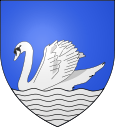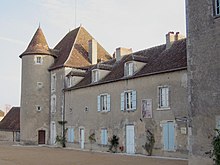Le Blanc
| Le Blanc | ||
|---|---|---|

|
|
|
| region | Center-Val de Loire | |
| Department | Indre | |
| Arrondissement | Le Blanc | |
| Canton | Le Blanc (main town) | |
| Community association | Brenne-Val de Creuse | |
| Coordinates | 46 ° 38 ′ N , 1 ° 4 ′ E | |
| height | 72-140 m | |
| surface | 57.61 km 2 | |
| Residents | 6,389 (January 1, 2017) | |
| Population density | 111 inhabitants / km 2 | |
| Post Code | 36300 | |
| INSEE code | 36018 | |
| Website | www.ville-leblanc.fr | |
 View over the Creuse to Le Blanc (Ville Basse), on the left the Viaduc du Blanc |
||
Le Blanc is a French municipality with 6389 inhabitants (at January 1, 2017) in the department of Indre in the Region Center-Val de Loire . The city is the administrative center of the Arrondissement of Le Blanc and the canton of Le Blanc .
geography
Le Blanc is located in the extreme southwest of the department of the river Creuse , in the natural landscape Boischaut North in the Regional Natural Park of Brenne . The place is located roughly in the middle between Poitiers and Châteauroux . Neighboring municipalities are (clockwise) Douadic , Rosnay , Ruffec , Bélâbre , Mauvières , Concremiers , Saint-Aigny and Pouligny-Saint-Pierre .
Surname
The name of the city is of Celtic origin , but its meaning is unclear. There is no connection with the French word "blanc" (English: white).
history

Le Blanc owes its existence to a ford through which the Creuse could be crossed. North of the ford, along a Roman road , the lower town (Ville Basse), which belonged to the province of Berry , was built around the church of Saint-Génitour . On the south side of the river were the castles Château Naillac (belonging to the Berry) and Château Donjon (province of Poitou ). The upper town (Ville Haute) with the church of Saint-Cyran was formed on the limestone slopes around the two fortresses.
In the Middle Ages the two cities were connected by a bridge. It was destroyed in a flood in 1530, and during the next 300 years it had to be put across the river on a ferry . The present bridge was built at the beginning of the 19th century.
Population development
| year | 1962 | 1968 | 1975 | 1982 | 1990 | 1999 | 2009 | 2017 |
| Residents | 6402 | 6767 | 8024 | 7769 | 7361 | 6998 | 6946 | 6389 |
Attractions
- Château Naillac with two towers from the 12th / 13th centuries century
- Église Saint-Cyran du Blanc, Romanesque church from the 12th century
- The 528 m long and 38 m high Viaduc du Blanc railway bridge on the Port-de-Piles and Saint-Benoît railway lines spans the Creuse valley
traffic
Streets
The departmental roads D 951 ( Poitiers - Châteauroux ) and the D 975 ( Châtillon-sur-Indre - La Trimouille ) cross in Le Blanc . The national road in the direction of Tours to La Celle-Saint-Avant , designated from 1933 as the N 750 , existed as such until 1973 and was then downgraded to the D 950.
The nearest motorway junctions are at Châtellerault or Poitiers ( Autoroute A 10 ) and Argenton-sur-Creuse ( A 20 ).
Rail transport
Le Blanc station is orphaned after it was closed to passenger traffic in 1953 and to goods traffic in 1994. It was opened on May 16, 1886 by the Compagnie du chemin de fer de Paris à Orléans (PO) and was initially the end point of the first section of the Port-de-Piles – Argenton-sur-Creuse railway . On November 7, 1887, the branch line from Le Blanc to Saint-Benoît went into operation, on November 17, 1902, the Chemin de fer du Blanc-Argent narrow-gauge railway coming from Romorantin-Lanthenay reached the place. In 1904 the meter-gauge line to Argenton-sur-Creuse via Saint-Benoît-du-Sault ( Tramways de l'Indre ) was opened, the station of which was on the station forecourt.
The latter was discontinued in 1938, and in 1940 tourist traffic on all standard-gauge routes ended. On September 1, 1953, the end section of the narrow-gauge line from Romorantin was closed.
partnership
- Bechhofen in Middle Franconia ( Germany ) is the partner municipality of Le Blanc.
Personalities
- Jeanne-Elisabeth Bichier des Ages (1773–1838), canonized in 1949
- Albert Chichery (1888–1944), Deputy 1932–1940; In 1940 he was briefly Minister of Trade and Industry in the Paul Reynaud and Philippe Pétain governments and member of the National Council under the Vichy regime. As an entrepreneur, he was a driving and motorcycle pioneer
- Pierre Barjot (1899-1960), Admiral, during the Suez Crisis active
- Philippe Lécrivain (1941-2020), Jesuit, historian






